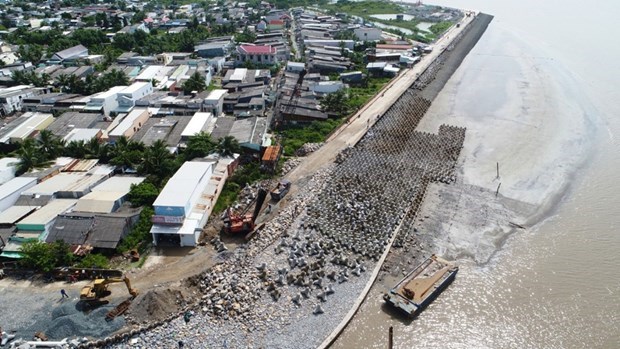Vietnam mobilises resources to implement climate change adaptation
Hanoi (VNA) – Prime Minister Nguyen Xuan Phuc has approved a national plan on climate change adaptation for the 2021-2030 period with a vision through 2050.
 Illustrative image (Source: CITI.IO)
Illustrative image (Source: CITI.IO)The plan is considered a foundation for Vietnam to effectively resources, enhance statement management, coordinate finance and technology and promote the engagement of the community, businesses and international organisations in implementing targets in climate change adaptation, thereby helping it to realise the sustainable development goals.
Minimising the vulnerability
Implementing the regulations of Article 7 of the Paris Agreement on Climate Change, Vietnam had built and approved the national plan on climate change adaptation. The plan was carefully built based on the guidance documents of the United Nations Framework Convention on Climate Change (UNFCCC) regarding the collection of information and date, analysis and assessment of impacts, hence setting out tasks and solutions to adapt to climate change.
The national plan on climate change adaptation for the 2021-2030 period with a vision through 2050 set a general goal of minimizing the vulnerability and risks from climate change by enhancing resilience and adaptive capacity of the community, economic sectors and ecosystems.
It also aimed to enhancing state management on climate change and promote the integration of climate change adaptation into strategies and planning schemes, the investment in adaptive activities, science and technologies, and the improvement of public awareness of this issue.
The plan also defined tasks and solutions to mitigate disaster risks and losses, and enhance the preparedness for natural disasters and extreme weather caused by climate change.
 The national plan on climate change adaptation will help enhance resilience and protect assets and lives of people (Photo courtesy of the Department of Climate Change)
The national plan on climate change adaptation will help enhance resilience and protect assets and lives of people (Photo courtesy of the Department of Climate Change)The tasks and solutions focus on seven specific groups and spheres: enhancing state management and resources; agriculture; natural disaster prevention, the environment and biodiversity; water resources; infrastructure and other fields (public health, labour-society, culture-sports-tourism).
Separation of implementation periods, progress supervision
As scheduled, the tasks and solutions for the implementation of the plan are separated in the periods of 2021-2025, 2026-2030 and the vision until 2050.
During its first phase from 2021-2025, the plan will focus on completing mechanisms and policies on climate change adaptation, making legal and technical preparations to promote the integration of climate change into policies, strategies and planning schemes, and implementing prioritised tasks and solutions.
From 2026-2030, greater efforts will be made to improve state management in climate change, and enhancing resilience of economic sectors, the community and the ecosystem.
 A sea dyke in the Mekong Delta province of Bac Lieu (Photo courtesy of the Department of Climate Change)
A sea dyke in the Mekong Delta province of Bac Lieu (Photo courtesy of the Department of Climate Change)Between 2030 and 2050, the plan will concentrate on improving adaptive capacity of people and infrastructure, and ensuring food, energy and water security, gender equality, social welfare, public’s health, and sustainable national development amidst climate change and natural disasters.
Mobilising resources from difference channels
Dr. Tang The Cuong, Director of the Department of Climate Change under the Ministry of Natural Resources and Environment, said to realise the plan, resources will be mobilized from different resources in line with regulations of the Budget Law, Law on Public Investment, Law on Investment and other legal documents.
Funding for the implementation of the plan can be sourced from the state budget, international assistance, businesses and community. Every year, the State allocates funding from the central and local budgets as well as international aid to carry out the plan, with priority given to the completion of mechanisms and policies.
In addition, the country can approach multilateral cooperation channels designed to support climate change adaptation such as the Global Environment Fund, Adaptation Fund and Green Climate Fund.
Vietnam is also likely to access technical assistance from multilateral institutions such as development banks and United Nations organisations as well as non-governmental organisations which support climate change adaption activities in the community and localities.
On this basis, the State builds a legal framework and uses economic and market tools to encourage and create favourable conditions for financial institutions and businesses both at home and abroad to invest in and support the implementation of the national plan on climate change adaptation./.













